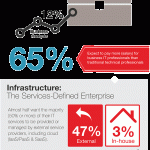As CIOs increasingly accept that line of business colleagues will take over IT purchasing decisions. Mark Rogers, President and COO at Logicalis, assesses their response - drawing on findings from the second annual Optimal Services Study to argue that they are actively seeking to re-shape IT departments as ‘internal service providers’.
Infographic - The Internal Service Provider
As the first in this series of post drawing on findings from the Optimal Services Study 2014 pointed out, line of business IT purchasing is no longer in the shadows – the IT power shift is very much the mainstream. The real question is not how CIOs can control shadow IT, but how they can embrace and adapt to it.
Further findings from the study give us a clear indication of how CIOs will do just that, and suggest that similar responses are emerging worldwide.
They suggest that CIOs are seeking to embrace a new, infrastructure and service management-focused role, increasingly seeing IT departments as ‘internal service providers’. Staffed by a new breed of business ICT professional, it appears these redefined IT organisations will focus more on managing externally provisioned services than on maintaining in-house technologies:
- 57% of CIOs agree that, by 2016, 80% of IT budgets will be based on providing service integration for a broad portfolio of internally and externally sources IT and business services
- 76% already consider that the IT function in their organisation is services focused rather than technically focused
- Almost half (41%) expect to rename the IT department in the next two years, to reflect a service-management role.
More specifically, these new departments will have to become experts in service integration. Simply, that is because line of business will want access to a growing number of market offerings delivering transformational line of business applications – making the selection, integration, governance and management of ‘as a service’ as important as maintaining in-house technologies.
In truth the survey bears out what we see on the ground in many businesses, that helping organisations to quickly respond to on-going business transformation requirements is now the CIO’s top priority.
All the same, CIOs recognise that there is much work to do in order to deliver this service-defined transformation. They will have to recruit specialists with broader, business IT orientated skills, they must slash the level of technology their teams maintain in house, and they must succeed where they have so far failed – in refocusing the CIO role on strategic activities.
It will be very interesting to see the extent to which CIOs are able to deliver this transformation over the next few years (a trend the Optimal Services Study will continue to observe) and, of course, exciting to bring our own capabilities to bear in helping them to succeed.


